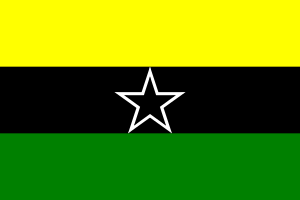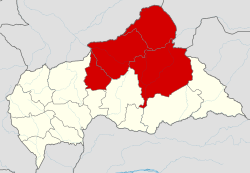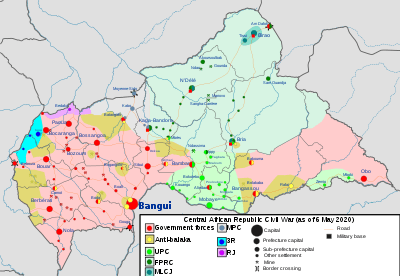Republic of Logone
The Republic of Logone, officially Dar El Kuti, is a partially-realized,[3] self-declared autonomous region and proto-state internationally recognised as part of the Central African Republic. It was formed by the Muslim rebel movement Popular Front for the Rebirth of Central African Republic (FPRC) on 14 December 2015.[4][5]
Dar El Kuti Dar El Kuti | |
|---|---|
 | |
 Territories claimed by Logone | |
| Capital and largest city | Kaga-Bandoro[1][2] |
| Government | One-party republic |
| Proto-state | |
• Independence declaration from the Central African Republic | 14 December 2015 |
| Time zone | UTC+1 (WAT) |
History

In March 2013, during the Central African Republic Civil War which began a year earlier, the Muslim Séléka rebels forced the Christian president of the Central African Republic François Bozizé from his office, resulting in violence from the Christian anti-balaka militias. The UN sent in MINUSCA troops and scheduled a constitutional referendum for 13 December 2015 and national elections on 27 December in order to stabilise the country.[6] However, Noureddine Adam, the leader of the Popular Front for the Rebirth of Central African Republic (FPRC), one of the four Muslim Séléka militias, abstained from the scheduled elections. In his view, Muslims and Christians could no longer live together in one country.[2][7] On December 14, 2015, Adam's spokesman, Maouloud Moussa, declared the autonomous Republic of Logone in the northeast of the country. He explained that they wanted first to achieve autonomy within the Central African Republic and eventually absolute independence.[8] Later, it was announced that the name of the new republic was "Dar El Kuti" after historic Dar El Kuti sultanate.
Louisa Lombard, a professor of anthropology at the Yale University, explained that it is possible that declaration of a new republic was a negotiating tactic for upcoming elections or a method for increasing influence, and that the rebels did not really believe that it is feasible to create a new state.[9]
References
- "Central African Republic : January 2016 Monthly Forecast : Security Council Report". Retrieved 22 April 2017.
- "Muslim rebels declare autonomous state in Central African Republic". Retrieved 22 April 2017.
- Fouchard, Anthony; André, James (13 July 2016). "Centrafrique : à la rencontre des ex-rebelles putschistes". France 24 (in French).
- Dembassa-Kette, By Crispin. "Rebel declares autonomous state in Central African Republic| Top News| Reuters". af.reuters.com.
- Pike, John. "Seleka". Retrieved 22 April 2017.
- "Voting extended for Central African referendum after violence". Reuters. 2015-12-14. Retrieved 2020-04-11.
- "Rebels in Central African Republic Seek Muslim-Christian States". Retrieved 22 April 2017.
- "Rebel declares new state in Central African Republic". Retrieved 22 April 2017.
- "Central African Republic: CAR Rebel Leader Declares Autonomous State". 16 December 2015. Retrieved 22 April 2017 – via AllAfrica.